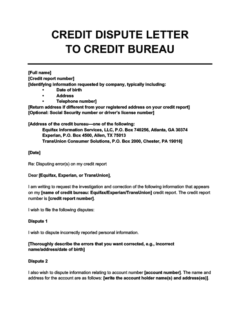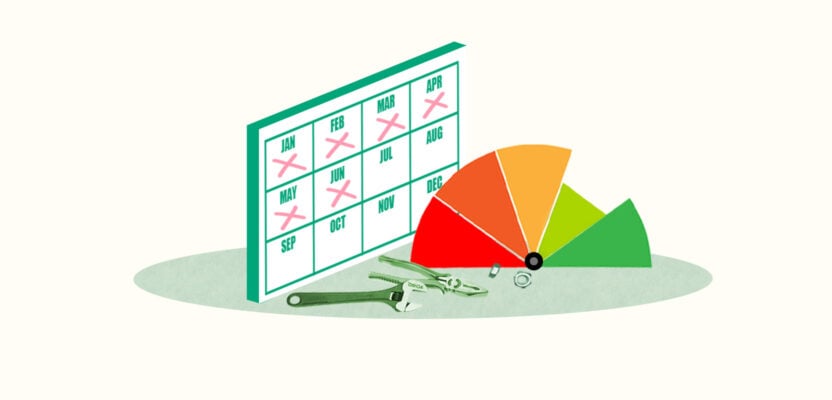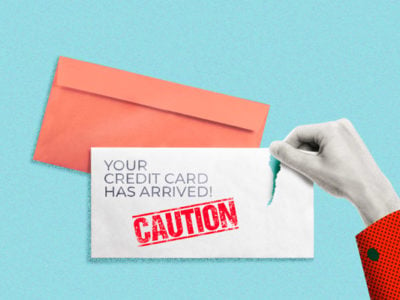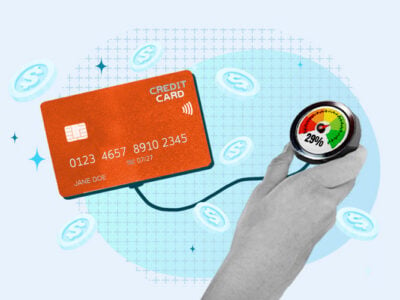Fixing your credit can be a challenge, even more so when you’re on a deadline. Thankfully, regardless of whether you’re starting with poor or fair credit, it’s possible to fix it up and increase your credit score in as little as 6 months.
To make the most of the time you have, take the right steps (in the right order) to quickly fix your credit so that you have a high enough credit score to access all the best loan offers.
Table of Contents
1. Check your credit reports
No matter how little time you have, how bad your credit is, or how high you want your credit score to be, the first step in any credit repair journey is taking a look at your credit reports to identify where to focus your efforts.
Start by requesting your free credit reports at AnnualCreditReport.com. Get a copy of your credit report from each of the three main credit bureaus (Experian, Equifax, and TransUnion). Take note of any mistakes or black marks that might be bringing your credit score down.
Dispute inaccuracies
If you find errors in your credit account details or personal information, dispute the items on your credit report to get the mistakes corrected.
Because the credit dispute process usually takes only 30 days, disputes can potentially fix your credit in just 1 month if they successfully erase bad credit. 1 If you have to file multiple disputes (sometimes the bureaus drag their feet when correcting mistakes), it may take longer, but you’ll still get results within 6 months.
Sending a dispute letter is quick and easy. All you need is a dispute letter template:

Credit Dispute Letter to a Credit Bureau
Use this credit dispute letter template to file a dispute directly with one of the credit bureaus. Mistakes in your personal information (e.g., an incorrect address), as well as credit accounts that you don't recognize, should usually be disputed with the bureaus. Often they're the result of the bureau confusing you for someone else.
For the best chance of success, make sure to also send any documentation or evidence you have supporting your case.
2. Diversify your credit file
If you need to fix your credit score and you don’t have much time to lose, one of the first things you should do is figure out whether you need any new tradelines in your credit file.
Adding new credit accounts to your portfolio won’t have a major impact on your score, but it can give you a small boost, and every little bit counts.
Applying for and opening new credit accounts temporarily lowers your credit score, so it’s best to get it out of the way sooner rather than later so that your credit has time to recover over the next 6 months.
Take a look at what credit accounts you have. A good credit mix consists of both revolving credit accounts (e.g., credit cards and store credit) and installment loans. Installment loans are a type of credit account where you receive a large amount upfront and repay it in fixed installments, e.g., student loans, mortgages, and auto loans.
How to fix a poor credit mix
The steps you’ll need to take to add diversity to your credit mix depend on the types of credit you need:
- If you only have credit cards: Apply for a small credit-builder loan with at least a 6- or 12-month loan term. These work the opposite way of other types of loans because you make payments first and get the “loan amount” later. You’ll avoid going into debt, and you’ll even come out with a bit of extra cash.
- If you only have loans: Apply for a credit card with as high a credit limit as possible. If you have poor credit, you may have to settle for a secured credit card. You can get a higher credit limit by putting down a larger credit card security deposit.
If you have no active credit accounts at all, then you can add both a credit card and loan to your credit file. However, never go into debt just for the sake of improving your credit. The main characteristic of high scorers is that they’re responsible borrowers.
3. Don’t apply for any other new credit accounts (or close old accounts)
Once you’re sure you’ve got all the credit accounts you need to optimize your credit mix, stop submitting credit applications. Don’t apply for any other new credit over the next 6 months (including store cards and card offers that you get in the mail).
When you apply for new credit, lenders and credit card companies will generally run a credit check. These checks trigger hard inquiries, and hard inquiries can take several points off your credit score (although admittedly this effect usually diminishes after 6 months).
You should also keep all of your current credit accounts open—especially your credit cards. Closing a credit card hurts your credit score by lowering the amount of available credit you have. It can also negatively affect your credit mix. 2
4. Remove negative marks from your credit report
If you have a bad credit score (or even a fair credit score), it’s likely that you have derogatory marks on your credit report. Although you usually need to wait 7 years for them to fall off your report, you may be able to get them deleted early.
Some people hire credit repair companies to help them do this, but it isn’t necessary. It’s possible to remove negative marks from your credit report by yourself.
Erasing negative marks will give your credit score a major boost and significantly improve how your credit history looks to lenders. Best of all, you can get very speedy results—certainly within half a year.
How to delete derogatory marks
You’ll need to ask the data furnishing company (your creditor, debt collector, or whoever is reporting negative information about you) to delete negative marks from your credit file.
You have two options for getting these marks removed:
- Pay for delete: This is a negotiation tactic wherein you write a letter offering payment toward an outstanding debt in exchange for deleting the associated mark. Draft your letter with this pay-for-delete letter template.
- Goodwill letter: If you’ve faced hardship in your life that’s negatively affected your credit, you can send your creditors a goodwill letter explaining your situation and asking them to delete the negative mark as an act of kindness. It’s a long shot, but using a goodwill letter template to create a convincing letter may be enough to convince them to clear your account history of damaging marks.
Neither of these approaches are guaranteed to work, but when they do, the results for your credit score can be spectacular.
5. Use less of your available credit
A major component of every major credit scoring model is your credit utilization rate (i.e., how much debt you have vs. the amount of credit available to you). Using less of your available credit is a simple way to fix a poor credit score and show lenders you can control your spending.
There are two main ways to increase your available credit in the next 6 months:
- Spend less on your credit cards: Don’t let your credit card balances reach 30% of your credit limit. For example, don’t spend more than $300 if you have a credit limit of $1,000. In fact, if you can get your utilization into the single digits, that’s even better; keep your balance as low as possible while ensuring the account stays active.
- Increase your credit card limits: If you’ve had a credit card for a while and generally used it responsibly, ask your credit card issuer to increase your credit card limit. If you’re approved, this will instantly increase how much available credit you have, lowering your utilization rate and instantly increasing your credit score.
6. Pay down your debts
Your credit score and report will be in the best shape if you have minimal debts. There are several ways to get out of debt and even specialized methods for getting out of credit card debt.
Focus on achieving these goals within the next 6 months:
- Pay off collections: Debts in collection are incredibly damaging to your credit score, and paying collections can improve your credit score in newer credit scoring models (like FICO 9, VantageScore 3.0, and VantageScore 4.0) by completely undoing their negative effects.
- Pay your loans down (but don’t pay them off): Bring your loan balances down, but don’t pay them off completely. Paying off a debt can cause a drop in your credit score for several reasons, but having a very low balance compared to the amount you originally borrowed will help your credit. 3
- Bring credit card balances down to $0: Although there’s a risk that your credit cards will become inactive if you stop using them, this isn’t an issue if you bring your balances down to zero during months 4 or 5 of your 6-month credit repair journey. In fact, it’ll help both your FICO and VantageScore credit scores if you have fewer accounts with balances. 3 4
If you have more debt than you can feasibly pay off, then just focus on getting your balances as low as possible. If you’re struggling, explore credit counseling or ask your creditors about hardship programs.
7. Pay all your bills on time for the next 6 months
Paying your bills on time every month may seem like a given, but don’t underestimate the power it has to fix bad credit (or make an already good credit score even better). Payment history is the most important credit scoring factor, which makes it the best area to focus your credit repair efforts.
Follow these steps to ensure you have a perfect payment history over the next 6 months:
- Catch up on missed payments: If any of your credit accounts are delinquent, bring them current as quickly as possible. Late payments hurt your credit score more as more time goes by, so address them as soon as possible.
- Always make the minimum payment: A partial payment is usually considered a late payment and will do the same damage to your credit as no payment at all. 5 If you have multiple bills, it’s better to make the minimum payment on all of them rather than let several become delinquent for the sake of making an extra payment on one.
- Don’t give up on a payment just because it’s late: Creditors don’t usually report payments as late until they’re at least 30 days overdue, so don’t give up on maintaining a good payment history just because you missed a deadline. 5
- Pay before the due date: Try to find out when your creditors report your account balance to the credit bureaus, and then pay your bills before this date. This will help you maintain the lowest possible balances on your credit report at all times and ensure your payments are never late.
If you’re at a point where it’s too late and you know you’re not going to be able to meet your payment due date, reach out to your creditor as soon as possible. They may be able to postpone your payments or reduce your required payment amount.
Follow all the steps above faithfully for the next 6 months. Once you reach your deadline, get new copies of your credit reports and check your credit score to see your progress. After that, all you need to do is focus on maintaining your good credit in the months and years to come.
Takeaway: There’s a lot you can do to fix your credit score in 6 months, as long as you know where to start.
- When repairing your credit, start by reviewing your credit reports. Check for errors and identify areas for improvement.
- Next, check whether you need any new credit accounts. If you plan on improving your credit mix or getting more credit cards, it’s best to do that sooner rather than later.
- You can dramatically increase your credit score by removing derogatory items from your credit report and using less of your available credit.
- During your 6-month credit repair period, focus on paying all your bills on time, paying down your debts, and keeping the same number of credit accounts open and active.







